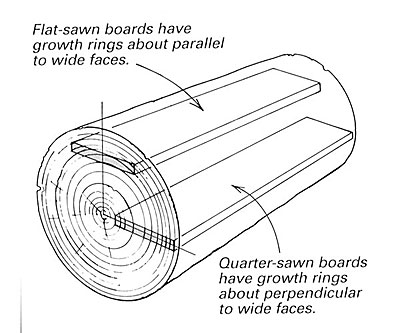Q:
While framing my house, I installed temporary stairs, intending to use the same 2×12 rough stringers for the finish stairs. In the usual nature of owner-builder projects, it was over a year later when I began work on the finish stairs.
Donald C. Brown, Ruckersville, VA
A:
Stephen Smulski, president of Wood Science Specialists in Shutesbury, Massachusetts, replies: You’re correct that the rise and run cuts on the 2×12 rough stringers no longer meet at right angles as a result of lumber shrinkage. I suspect that shrinkage occurs in almost every stair built with conventional framing lumber. The treads on both stairs in my home are slightly out of level. Fortunately, the slant is so slight that it goes unnoticed.
Fastening finish treads and risers to the carriage before it dries isn’t likely to do any good. On the contrary, you’ll probably end up with popped nails or squeaky stairs as the carriage shrinks away from the back of treads and risers.
Shrinkage of framing lumber can’t be stopped. You can minimize the potential for shrinkage by choosing lumber stamped S-Dry (surface dried to 19% moisture content) or KD15 (kiln dried to 15% moisture content). Try buying a few 2x12s ahead of time so that they’ll partially dry and shrink before you use them. Stack and sticker the 2x12s indoors. As 2x12s are almost always flat-sawn (see drawing), you may have to weigh the 2x12s down to reduce cupping. If the stair design permits, use 2x10s, which will shrink less than 2x12s. But remember, the depth of the uncut portion of the rough stringer must be at least 3-1/2 in.
You could use laminated veneer lumber (LVL) for rough stringers. Manufactured at a moisture content of around 12%, shrinkage of LVL after installation is practically nil. Another dry-wood alternative is a prefabricated stair whose treads and risers are leveled and plumbed with wedges.
Whatever you do, to minimize the possibility of nail pops and squeaks, I recommend that construction adhesive always be applied to the rough stringer before treads and risers are fastened. Also, using spiral or ring-shank nails is a good idea because they won’t pop as easily as smooth nails do.

Fine Homebuilding Recommended Products
Fine Homebuilding receives a commission for items purchased through links on this site, including Amazon Associates and other affiliate advertising programs.

Smart String Line

Original Speed Square

100-ft. Tape Measure

























